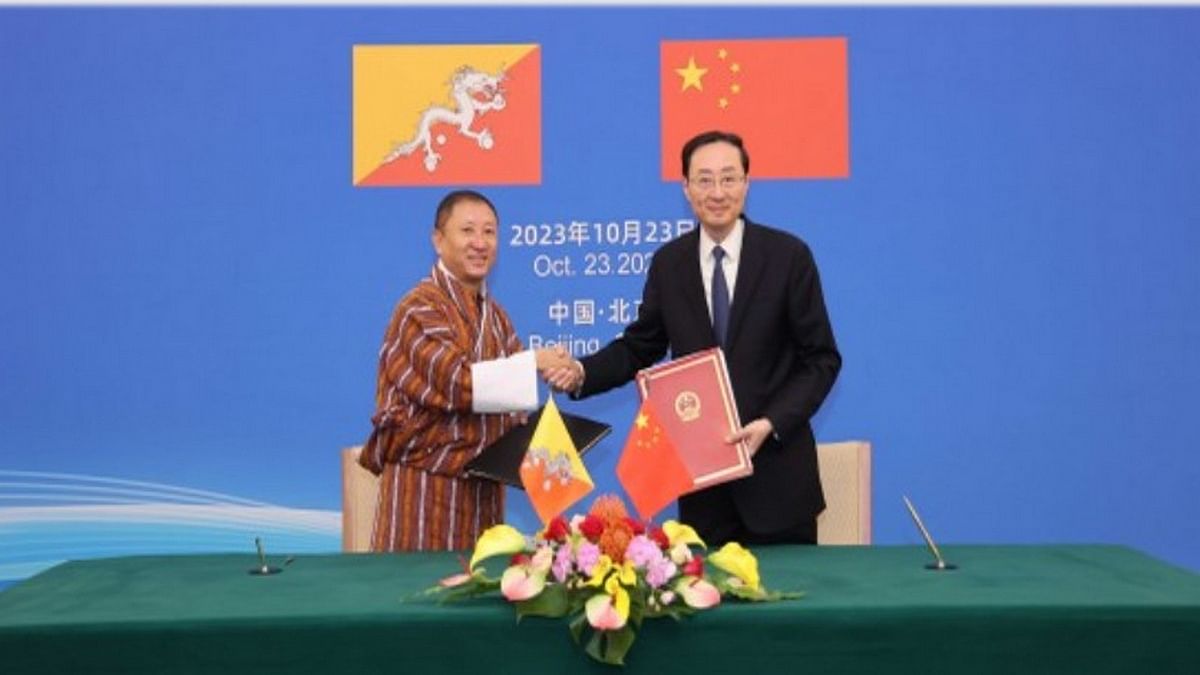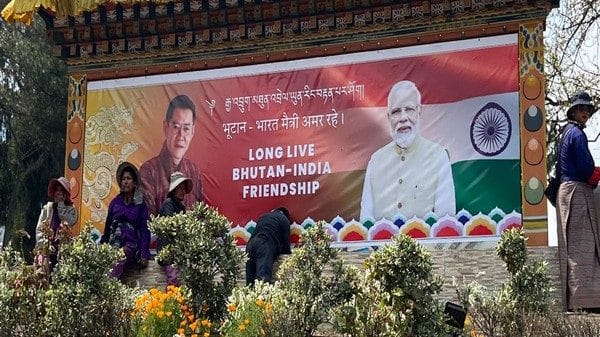Prime Minister Narendra Modi is in Bhutan to reinforce India’s special relationship with Thimphu. The significance of the visit’s timing, amid the ongoing boundary negotiations between Bhutan and China, is not lost on anyone. The visit brings the focus back on China’s gray zone warfare in the Himalayas.
China’s gray zone warfare toolkit includes legal, political, diplomatic, economic, and psychological means, among others, to coerce and subdue other states to align with Chinese interests. Infrastructure development programmes in the border areas, which enhance military capabilities, is one such strategy widely used to undermine Bhutan’s sovereignty.
In 2017, China launched a programme to build “well-off villages in border areas,” under which at least 628 villages are being constructed along the frontier with India and Bhutan. These villages, along with supporting infrastructure, will enable China to stabilise and consolidate the border. Since then, it has taken several steps—passage of the Land Borders Law, renaming of places, building infrastructure in disputed areas—to strengthen its claims on the border with Bhutan.
Chinese attempts to undermine Bhutan’s sovereignty, a country much smaller than itself, are not recent but have been ongoing for a very long time.
Also read: Does China-Bhutan thaw signal trouble for India? Not quite
China’s claims and boundary resolution attempts
According to some accounts, the 18th-century Tibetan ruler Polhane apparently held suzerainty over Bhutan. In the1930s, Mao vicariously claimed Bhutanese territories based on the Qing dynasty’s debatable rule over Tibet. This claim has been rejected by Bhutanese scholars as ‘vague’ and misinformation. The claims of the Qing emperors were later renounced by China in the early 1970s when relations between the two countries became amicable. China, for the first-time, acknowledged Bhutan as a sovereign country, allowing it to break free from the stated Chinese rhetoric of middle kingdom suzerainty following the 1998 treaty to maintain peace and tranquility in the border area.
China’s occupation of Tibet in 1950 came as a rude shock to all its neighbours. To the credit of Indian diplomacy, New Delhi had moved swiftly and signed treaties with Nepal (31 July 1950), Sikkim (15 December 1950), and Bhutan (8 August 1949), thereby attempting to secure the region from Chinese military threat and malign intent, which has become so evident in recent times.
The 1959 Tibetan uprising and the consequential brutal Chinese reprisal and the influx of Tibetan refugees led Bhutan to close its borders with Tibet. To some extent, the Indian military setbacks of 1962 might have made Bhutan rethink its policy of isolationism, and attempts were made to normalise relations with China. In 1971, Bhutan joined the United Nations and even voted to recognise the People’s Republic of China (PRC) as the government. It supports the ‘One China Policy’ and maintains cultural and trade relations with China.
Bhutan and China began their boundary talks in the 1980s, and the two sides signed the ‘Guiding Principles on the Settlement of the Boundary Issues’ in 1988 and the ‘Agreement on Maintenance of Peace and Tranquility along the Sino–Bhutanese Border Areas’ in 1998. These two agreements form the basis of boundary negotiations between the two countries. In October 2021, China and Bhutan signed the MoU on a Three-Step Roadmap. Between 1984 and October 2023, twenty-five rounds of China-Bhutan boundary talks and thirteen expert group meetings (EGMs) on Bhutan-China boundary issues have been conducted. Following the 13th EGM, a joint technical team was set up for delimitation of the disputed border between the two countries. The Three-Step Roadmap and the constitution of the joint technical team provide a sense of forward momentum in the resolution of boundary disputes between the two countries.

China is following a two-pronged approach in boundary settlement with Bhutan. On the one hand, it maintains a façade of a responsible and mature party in boundary negotiations, and on the other hand, it is surreptitiously changing facts on the ground by occupying Bhutanese territory. In fact, China first experimented with the ‘salami-slicing’ strategy in Bhutan before implementing it in the South China Sea.
There are three areas of dispute between Bhutan and China: Sakteng in the east, Beyul Khenpajong and the Menchuma Valley in the north, and parts of Doklam, Charithang, Sinchulungpa, Dramana, and Shakhatoe in the west. Since 1990, China has reportedly been offering to give up 495 square kilometres of its so-called claims in the north if Bhutan yields 269 square kilometres of its territory in the west. This is after Bhutan voluntarily relinquished its claim to the Kula Khari area in the 1980s, attributing its earlier claim to a cartographic error.

China has been claiming some areas in the north and west for a long time, but the so-called Chinese claim over Sakteng in eastern Bhutan is of recent origin. Twenty-four rounds of boundary negotiations had taken place until 2016, and the issue of Sakteng was never raised. For the first time in June 2020, China announced Sakteng as a disputed territory. The fact that it happened when India and China were locked in a military standoff in Ladakh is indicative of the India connection.
The so-called Chinese claims in the north of Bhutan are even more preposterous. Both the Beyul and the Menchuma Valley were shown as parts of Bhutan on official Chinese maps until at least the 1980s and on some of the tourist maps in the late 1990s. The Chinese claim over Beyul is based on a directive of the Jiaqing Emperor (reigned 1796-1820) granting grazing rights to herders belonging to the monastery of Lhalung in western Lhodrak, in southern Tibet. The official documents of the emperor granting grazing rights have never been made public, and in the absence of any document, the Chinese claim appears to be a sham.
China’s so-called claims in western Bhutan concern India the most. Chinese control over the claimed areas will enable it to enlarge the narrow Chumbi Valley and bring its forces closer to the Siliguri Corridor through Doklam.
India is Bhutan’s most reliable partner
China has been increasingly employing gray zone tactics in pursuit of its perceived core interests with blatant disregard to internationally recognised norms and treaties. These activities are below the threshold of military confrontation yet enable it to alter the regional status quo in its favour. India would do well to hold gray zone scenario discussions with Bhutan to better understand its concerns, needs, and responses to thwart China’s nefarious designs.
Col (Dr) Rajneesh Singh (Retd) is a Research Fellow at MP-IDSA, New Delhi. Views are personal.
(Edited by Prashant)






